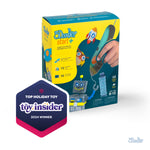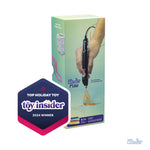Boost classroom confidence through a series of STEM lessons that enable students to work in teams and engage in critical thinking skills. Science and math concepts can sometimes be hard to understand. With a unique hands-on approach, students will grasp new ideas in no time!
The 3Doodler lessons span grades K-8 with creative exploration that will have students embracing new ideas. Combine these activities with other resources we’ve rounded up for a completely new approach to tried and true topics.
Grade K-2: Basic Needs of Plants & Animals
To survive, plants and animals have different needs, which we can break down in this hands-on lesson. Students will break into groups and explore the needs of plants and animals using the free worksheet. Working together, they will first trace or draw the symbols for the items listed on the sheet. Then, they will doodle their designs using a 3Doodler Start+ 3D printing pen. Once the symbols are ready, students can use a Venn diagram to compare the needs of the animals with the needs of plants. Students could deepen their understanding by studying the needs of animals from different habitats.
Consider closing this lesson with a video and resources from Plum Landing by PBS to see how plants and animals thrive in a city. This colorful and creative lesson will invite playful exploration of what animals and plants need to survive!
Grade 3-5: Cloud Doodles
With the change of seasons, there’s no better time to observe the science around us. A quick look up at the sky reveals many scientific observations, and for this lesson, we will be looking at different cloud types with a fun twist. By working in small groups, students will be asked to learn about four different types of clouds, study their shape, and research the weather conditions associated with each cloud. Once the research is complete, the students will create cloud doodles and then repurpose them as everyday objects, animals, or people — a poodle, a boat, or car fumes.
Extend learning with a lesson on how clouds affect climate from NASA. Students will appreciate the vital role clouds play in the water cycle and reflect on their understanding. What do you see when you look at the clouds?
Grade 6-8: Bridging the Gap
Bridges have played an essential role throughout history in providing access to routes to transport people and goods. Over time, the design of bridges has evolved from a simple slab to modern structural marvels. In this lesson, students will work in small groups to explore different bridge shapes and their structural elements.
Challenge students to create a bridge that spans 20 centimeters and test its weight-bearing ability with a small car or other materials. Gradually increase the weight to see which group built the strongest bridge. It’s a fantastic way to combine multiple subject areas, from history, architecture, and design to science, math, and engineering. Encourage the teams to reflect on what worked well, what didn’t, and how they could have improved their design.
Consider kicking this lesson off with a bit of history. The oldest surviving bridge in the United States is the Frankford Avenue Bridge in Philadelphia, built in 1867. It played an important role in linking Philadelphia to cities in the north, namely Trenton, New York, and Boston. Speaking of New York, the iconic Brooklyn Bridge was completed in 1883 and was the longest suspension bridge of its time. Much more to learn about the role bridges have played throughout history!



